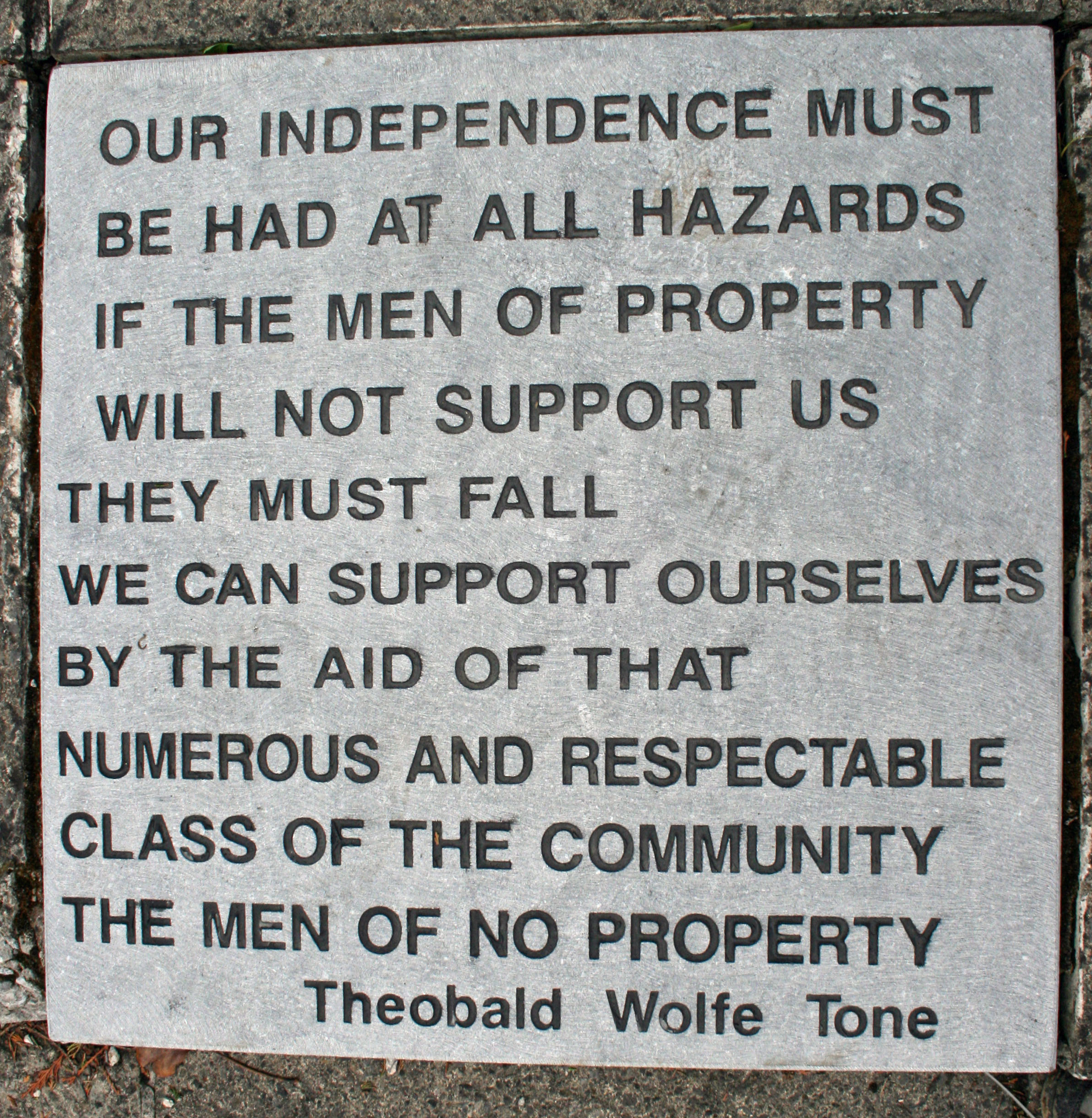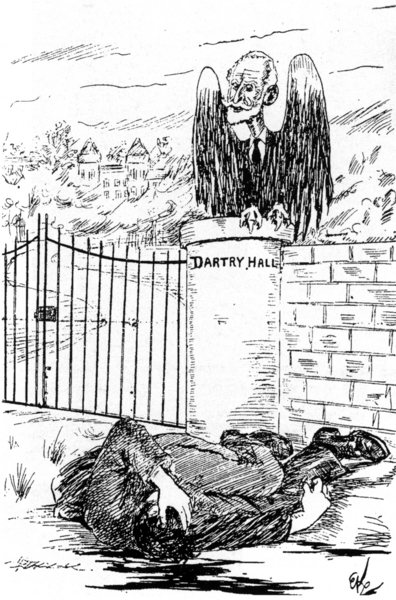|
September 1913 (poem)
"September 1913" is a poem by W. B. Yeats. The poem was written midway through his life as a highly reflective poem which is rooted within the turbulent past. Most notably, the poem provides insight into Yeats' detestation of the middle classes whilst also glorifying figures such as John O'Leary. Poem What need you, being come to sense, But fumble in a greasy till And add the halfpence to the pence And prayer to shivering prayer, until You have dried the marrow from the bone; For men were born to pray and save; Romantic Ireland's dead and gone, It's with O'Leary in the grave. Yet they were of a different kind, The names that stilled your childish play, They have gone about the world like wind, But little time had they to pray For whom the hangman's rope was spun, And what, God help us, could they save? Romantic Ireland's dead and gone, It's with O'Leary in the grave. Was it for this the wild geese spread The grey wing upon every tide; For this that all that blood was shed, For ... [...More Info...] [...Related Items...] OR: [Wikipedia] [Google] [Baidu] |
John O'Leary (Fenian)
John O'Leary (23 July 1830 – 16 March 1907Alan O'Day, O'Leary, John (1830–1907), Oxford Dictionary of National Biography, Oxford University Press, Sept 2004; online edn, May 2006) was an Irish separatist and a leading Fenian. He studied both law and medicine but did not take a degree and for his involvement in the Irish Republican Brotherhood he was imprisoned in England during the nineteenth century. Early life Born in the town of Tipperary, County Tipperary, the Catholic O'Leary was educated at the local Protestant Grammar School, The Abbey School, and later the Catholic Carlow College. He identified with the views advocated by Thomas Davis and met James Stephens in 1846. He began his studies in law at Trinity College, Dublin, in 1847, where, through the Grattan Club, he associated with Charles Gavan Duffy, James Fintan Lalor and Thomas Francis Meagher. 1848 rising After the failure of the 1848 Tipperary Revolt, O'Leary attempted to rescue the Young Ireland l ... [...More Info...] [...Related Items...] OR: [Wikipedia] [Google] [Baidu] |
Penny (Irish Decimal Coin)
The decimal one penny (1p) ( ga, pingin) coin was the second smallest denomination of the Irish pound. There were 100 pennies (pence) to the pound. The coin was first issued on Decimal Day, 15 February 1971. It was the second of three new designs introduced all in bronze, the others being a half-penny and a two pence coin. All featured ornamental birds designed by Irish artist Gabriel Hayes on the reverse. The coin originally had a diameter of 2.032 centimetres and mass of 3.564 grams consisting of copper, tin and zinc. This was identical to the British decimal penny as the two countries' pounds were pegged until 1979. The coin's official designation was "new penny" and this was changed in 1985 to "penny". In 1990 the decision was taken to produce the coin on a copper-plated steel base as the bronze had become too expensive. The steel base coins are magnetic. The coin was designed by the Irish artist Gabriel Hayes and the design is adapted from the Book of Kells held in ... [...More Info...] [...Related Items...] OR: [Wikipedia] [Google] [Baidu] |
Bone Marrow
Bone marrow is a semi-solid tissue found within the spongy (also known as cancellous) portions of bones. In birds and mammals, bone marrow is the primary site of new blood cell production (or haematopoiesis). It is composed of hematopoietic cells, marrow adipose tissue, and supportive stromal cells. In adult humans, bone marrow is primarily located in the ribs, vertebrae, sternum, and bones of the pelvis. Bone marrow comprises approximately 5% of total body mass in healthy adult humans, such that a man weighing 73 kg (161 lbs) will have around 3.7 kg (8 lbs) of bone marrow. Human marrow produces approximately 500 billion blood cells per day, which join the systemic circulation via permeable vasculature sinusoids within the medullary cavity. All types of hematopoietic cells, including both myeloid and lymphoid lineages, are created in bone marrow; however, lymphoid cells must migrate to other lymphoid organs (e.g. thymus) in order to complete maturation. ... [...More Info...] [...Related Items...] OR: [Wikipedia] [Google] [Baidu] |
Lord Edward FitzGerald
Lord Edward FitzGerald (15 October 1763 – 4 June 1798) was an Irish aristocrat who abandoned his prospects as a distinguished veteran of British service in the American War of Independence, and as an Irish Parliamentarian, to embrace the cause of an independent Irish republic. Unable to reconcile with Ireland's Protestant Ascendancy or with the Kingdom's English-appointed administration, he sought inspiration in revolutionary France where, in 1792, he met and befriended Thomas Paine. From 1796 he became a leading proponent within the Society of United Irishmen of a French-assisted insurrection. On the eve of the intended uprising in May 1798 he was fatally wounded in the course of arrest. Early years FitzGerald, the fifth son of the 1st Duke of Leinster and the Lady Emily Lennox (daughter of Charles Lennox, 2nd Duke of Richmond), was born at Carton House, near Dublin. In 1773 his father died and his mother soon afterwards married William Ogilvie, who had been the tutor for ... [...More Info...] [...Related Items...] OR: [Wikipedia] [Google] [Baidu] |
Robert Emmet
Robert Emmet (4 March 177820 September 1803) was an Irish Republican, orator and rebel leader. Following the suppression of the United Irish uprising in 1798, he sought to organise a renewed attempt to overthrow the British Crown and Protestant Ascendancy in Ireland, and to establish a nationally representative government. Emmet entertained, but ultimately abandoned, hopes of immediate French assistance and of coordination with radical militants in Great Britain. In Ireland, many of the surviving veterans of '98 hesitated to lend their support, and his rising in Dublin in 1803 proved abortive. Emmet’s Proclamation of the Provisional Government to the People of Ireland, his Speech from the Dock, and his "sacrificial" end on the gallows inspired later generations of Irish republicans. Patrick Pearse, who in 1916 was again to proclaim a provisional government in Dublin, declared Emmet's attempt "not a failure, but a triumph for that deathless thing we call Irish Nationality" ... [...More Info...] [...Related Items...] OR: [Wikipedia] [Google] [Baidu] |
Wolfe Tone
Theobald Wolfe Tone, posthumously known as Wolfe Tone ( ga, Bhulbh Teón; 20 June 176319 November 1798), was a leading Irish revolutionary figure and one of the founding members in Belfast and Dublin of the United Irishmen, a republican society determined to end British rule, and achieve accountable government, in Ireland. Throughout his political career, Tone was involved in a number of military engagements against the British navy. He was active in drawing Irish Catholics and Protestants together in the United cause, and in soliciting French assistance for a general insurrection. In November 1798, on his second attempt to land in Ireland with French troops and supplies, he was captured by British naval forces. The United Irish risings of the summer had already been crushed. Tone died in advance of his scheduled execution, probably, as modern scholars generally believe, by his own hand. Later generations were to regard Tone as the father of Irish Republicanism. His grave in ... [...More Info...] [...Related Items...] OR: [Wikipedia] [Google] [Baidu] |
William Blake
William Blake (28 November 1757 – 12 August 1827) was an English poet, painter, and printmaker. Largely unrecognised during his life, Blake is now considered a seminal figure in the history of the poetry and visual art of the Romantic Age. What he called his " prophetic works" were said by 20th-century critic Northrop Frye to form "what is in proportion to its merits the least read body of poetry in the English language". His visual artistry led 21st-century critic Jonathan Jones to proclaim him "far and away the greatest artist Britain has ever produced". In 2002, Blake was placed at number 38 in the BBC's poll of the 100 Greatest Britons. While he lived in London his entire life, except for three years spent in Felpham, he produced a diverse and symbolically rich collection of works, which embraced the imagination as "the body of God" or "human existence itself". Although Blake was considered mad by contemporaries for his idiosyncratic views, he is held in high regard b ... [...More Info...] [...Related Items...] OR: [Wikipedia] [Google] [Baidu] |
Percy Shelley
Percy Bysshe Shelley ( ; 4 August 17928 July 1822) was one of the major English Romantic poets. A radical in his poetry as well as in his political and social views, Shelley did not achieve fame during his lifetime, but recognition of his achievements in poetry grew steadily following his death and he became an important influence on subsequent generations of poets including Robert Browning, Algernon Charles Swinburne, Thomas Hardy, and W. B. Yeats. American literary critic Harold Bloom describes him as "a superb craftsman, a lyric poet without rival, and surely one of the most advanced sceptical intellects ever to write a poem." Shelly's reputation fluctuated during the 20th century, but in recent decades he has achieved increasing critical acclaim for the sweeping momentum of his poetic imagery, his mastery of genres and verse forms, and the complex interplay of sceptical, idealist, and materialist ideas in his work. Among his best-known works are "Ozymandias" (1818), "Ode to ... [...More Info...] [...Related Items...] OR: [Wikipedia] [Google] [Baidu] |
Dublin Lock-out
The Dublin lock-out was a major industrial dispute between approximately 20,000 workers and 300 employers that took place in Ireland's capital and largest city, Dublin. The dispute, lasting from 26 August 1913 to 18 January 1914, is often viewed as the most severe and significant industrial dispute in Irish history. Central to the dispute was the workers' right to unionise. Background Poverty and housing Many of Dublin's workers lived in terrible conditions in tenements. For example, over 830 people lived in just 15 houses in Henrietta Street's Georgian tenements. At 10 Henrietta Street, the Irish Sisters of Charity ran a laundry that was inhabited by more than 50 single women. An estimated four million pledges were taken in pawnbrokers every year. The infant mortality rate among the poor was 142 per 1,000 births, extraordinarily high for a European city. The situation was made considerably worse by the high rate of disease in the slums, which was worsened by the lack of ... [...More Info...] [...Related Items...] OR: [Wikipedia] [Google] [Baidu] |
Hugh Lane
Sir Hugh Percy Lane (9 November 1875 – 7 May 1915) was an Irish art dealer, collector and gallery director. He is best known for establishing Dublin's Municipal Gallery of Modern Art (the first known public gallery of modern art in the world) and for his contribution to the visual arts in Ireland, including the Lane Bequest. Hugh Lane died on board the RMS ''Lusitania''. Family Hugh Percy Lane was born in County Cork, Ireland, on 9 November 1875. He was the son of a rector father, and his mother Adelaide was a daughter of Dudley Persse, of Roxburgh, Co Galway and her sister was the dramatist Augusta, Lady Gregory, of Coole, Co Galway. He was brought up in Cornwall, England, and began his career as an apprentice painting restorer with Martin Henry Colnaghi in London, then worked as an art dealer at the Colnaghi's Marlborough Gallery for some years, before becoming a dealer in his own right and opening a gallery in Dublin in 1908. Through regular visits to Coole (near ... [...More Info...] [...Related Items...] OR: [Wikipedia] [Google] [Baidu] |







